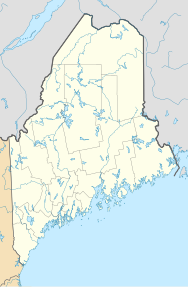North Oxford, Maine
| North Oxford, Maine | |
|---|---|
| Unorganized territory | |
| Location within the state of Maine | |
| Coordinates: 44°54′29″N 70°55′04″W / 44.90806°N 70.91778°WCoordinates: 44°54′29″N 70°55′04″W / 44.90806°N 70.91778°W | |
| Country | United States |
| State | Maine |
| County | Oxford |
| Area | |
| • Total | 546.2 sq mi (1,414.7 km2) |
| • Land | 509.6 sq mi (1,319.9 km2) |
| • Water | 36.6 sq mi (94.8 km2) |
| Elevation | 1,463 ft (446 m) |
| Population (2000) | |
| • Total | 17 |
| • Density | 0.0/sq mi (0.0/km2) |
| Time zone | Eastern (EST) (UTC-5) |
| • Summer (DST) | EDT (UTC-4) |
| Area code(s) | 207 |
| FIPS code | 23-52575 |
| GNIS feature ID | 582634 |
North Oxford is an unorganized territory in Oxford County, Maine, United States. The population was 17 at the 2000 census.
According to the United States Census Bureau, the unorganized territory has a total area of 546.2 square miles (1,414.7 km²), of which, 509.6 square miles (1,319.9 km²) of it is land and 36.6 square miles (94.8 km²) of it (6.70%) is water.
The territory consists of fifteen townships, which are Riley, Grafton, Andover North Surplus, Andover West Surplus, Township C, C Surplus, Richardsontown, Adamstown, Lower Cupsuptic, Parkertown, Upper Cupsuptic, Lynchtown, Oxbow, Parmachenee, and Bowmantown. The terrain is mountainous with little level ground suitable for raising crops; and the elevation causes frost in June and August leaving a growing season of about 60 days.
Grafton, the southernmost township, was the only township to achieve incorporation. The first European settler was James Brown in 1834. He built a sawmill in 1838, and a few of the men he hired to cut logs and mill lumber built homes along what is now Maine State Route 26 above Grafton Notch State Park. A few raised some livestock, hay, oats, and potatoes for subsistence. Grafton incorporated in 1852. The town school built just above Grafton Notch had 37 students by 1859, but that number slowly declined to 10 by 1900. The maximum population recorded for the town was 115 in the 1880 census. About a hundred men would come into Grafton for the winter logging season, and leave driving the logs downstream with the spring snowmelt in March or April. The intensity of logging increased in 1893 with completion of the Success Pond Railroad from Berlin, New Hampshire to the New Hampshire border of Grafton. Aboriginal forests had been completely logged when the railroad was dismantled in 1907. When the logging jobs disappeared, most residents sold their land to a pulp and paper company and moved away. Grafton disincorporated in 1919; and the Town records were turned over to Newry, Maine. Most of the structures were demolished by the new landowner to reduce the fire hazard of use by a transient population.
...
Wikipedia

